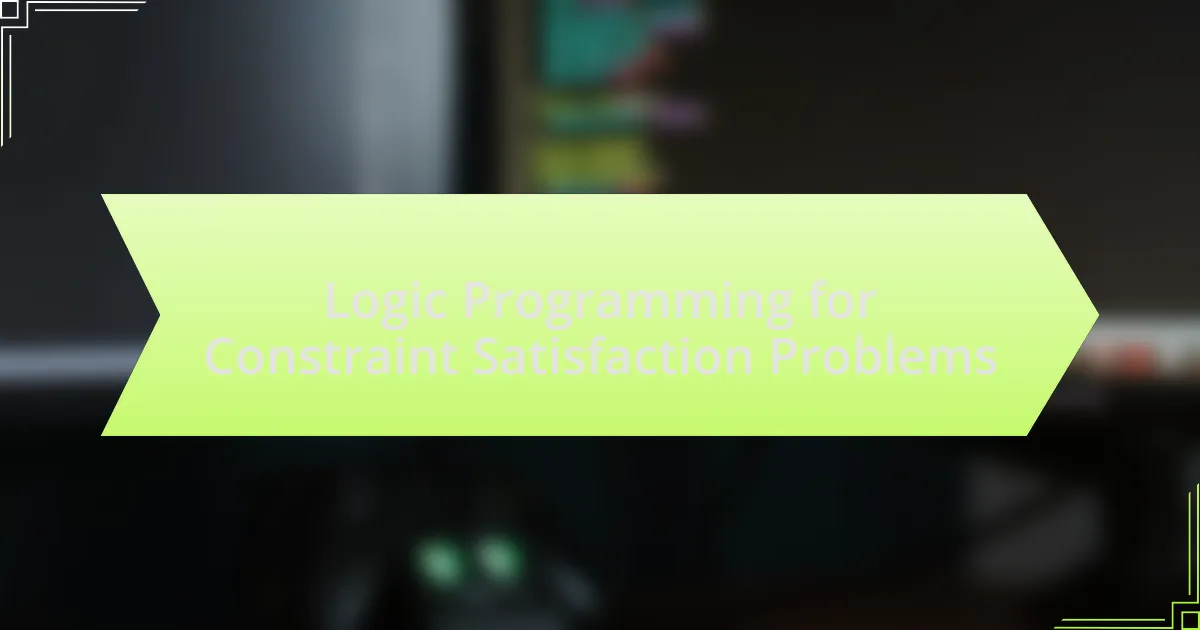Logic programming for constraint satisfaction problems (CSPs) is a computational paradigm that employs logic programming languages to express and solve problems defined by constraints. This article explores the relationship between logic programming and CSPs, detailing the fundamental principles, key components, and various types of constraints involved. It also examines the techniques used in logic programming, such as backtracking and constraint propagation, and discusses the advantages of this approach in enhancing problem-solving efficiency. Additionally, the article highlights real-world applications across industries, including scheduling and resource allocation, while providing best practices for effective implementation and common pitfalls to avoid.

What is Logic Programming for Constraint Satisfaction Problems?
Logic programming for constraint satisfaction problems (CSPs) is a paradigm that utilizes logic programming languages to express and solve problems defined by constraints. In this context, logic programming allows for the representation of variables, domains, and constraints in a declarative manner, enabling automated reasoning and search techniques to find solutions that satisfy all specified constraints. This approach is validated by its application in various domains, such as scheduling, resource allocation, and configuration problems, where CSPs are prevalent and logic programming frameworks like Prolog have been effectively employed to derive solutions through backtracking and constraint propagation methods.
How does Logic Programming relate to Constraint Satisfaction Problems?
Logic programming is fundamentally related to constraint satisfaction problems (CSPs) as it provides a declarative framework for expressing and solving these problems. In logic programming, constraints can be represented as logical formulas, allowing for the specification of relationships and conditions that must be satisfied. This relationship is evident in systems like Prolog, where constraints can be directly encoded and solved using backtracking algorithms. Research has shown that logic programming techniques can efficiently handle CSPs by leveraging constraint propagation and search strategies, making it a powerful tool for solving complex combinatorial problems.
What are the fundamental principles of Logic Programming?
The fundamental principles of Logic Programming include the use of formal logic as a programming paradigm, the representation of knowledge through facts and rules, and the execution of programs via a process of logical inference. Logic Programming operates on the basis of a declarative approach, where the programmer specifies what the program should accomplish rather than how to achieve it. This paradigm relies on a set of logical statements, typically expressed in predicate logic, which can be used to derive conclusions through resolution and unification processes. These principles enable efficient problem-solving in areas such as artificial intelligence and constraint satisfaction, where logical relationships and constraints are crucial for deriving solutions.
How do Constraint Satisfaction Problems function within Logic Programming?
Constraint Satisfaction Problems (CSPs) function within Logic Programming by representing problems as a set of variables, domains, and constraints that must be satisfied. In this framework, logic programming languages, such as Prolog, allow for the expression of these variables and constraints in a declarative manner, enabling the use of inference mechanisms to explore possible solutions. The resolution process in logic programming systematically searches through the variable assignments while checking constraints, ensuring that only valid solutions are considered. This approach is validated by the effectiveness of logic programming in solving CSPs, as demonstrated in various applications, including scheduling and resource allocation, where the ability to express complex relationships and constraints is crucial for finding optimal solutions.
What are the key components of Logic Programming for Constraint Satisfaction Problems?
The key components of Logic Programming for Constraint Satisfaction Problems include variables, domains, constraints, and inference mechanisms. Variables represent the unknowns that need to be assigned values, while domains define the possible values that each variable can take. Constraints specify the relationships and restrictions between the variables, guiding the solution process. Inference mechanisms are algorithms used to deduce variable assignments that satisfy all constraints. These components work together to systematically explore potential solutions, ensuring that all conditions are met, which is fundamental in solving constraint satisfaction problems effectively.
What types of constraints are commonly used in these problems?
Common types of constraints used in constraint satisfaction problems include unary, binary, and global constraints. Unary constraints involve a single variable and restrict its possible values, while binary constraints involve pairs of variables and define relationships between them. Global constraints, on the other hand, apply to a set of variables and capture more complex relationships, such as all-different or sum constraints. These constraints are essential in logic programming as they help define the solution space and guide the search for feasible solutions.
How do variables and domains interact in Logic Programming?
In Logic Programming, variables represent unknown values, while domains define the possible values that these variables can take. The interaction between variables and domains is crucial for solving constraint satisfaction problems, as constraints restrict the values that variables can assume based on their domains. For instance, in a scheduling problem, a variable might represent a time slot, and its domain could include all possible time slots available. The constraints would then eliminate certain time slots based on other scheduled events, effectively narrowing down the domain of the variable. This interaction ensures that the solution adheres to the specified constraints, leading to valid and feasible outcomes in logic programming scenarios.
What are the advantages of using Logic Programming for Constraint Satisfaction Problems?
Logic programming offers several advantages for solving constraint satisfaction problems (CSPs). Firstly, it provides a declarative approach, allowing users to specify constraints without detailing the control flow, which simplifies problem formulation. This abstraction enables easier modifications and enhancements to the constraints as needed. Additionally, logic programming languages, such as Prolog, inherently support backtracking and search strategies, which are essential for efficiently exploring potential solutions to CSPs.
Moreover, the use of unification in logic programming facilitates the automatic handling of variable bindings, streamlining the process of finding solutions that satisfy all constraints. Empirical studies have shown that logic programming can outperform traditional imperative programming approaches in terms of both development time and solution efficiency for CSPs, particularly in complex scenarios involving numerous variables and constraints.
How does it improve problem-solving efficiency?
Logic programming improves problem-solving efficiency by enabling the systematic representation and manipulation of constraints. This approach allows for the automatic deduction of solutions through logical inference, significantly reducing the time and effort required to explore potential solutions. For instance, in constraint satisfaction problems, logic programming can efficiently prune the search space by eliminating inconsistent possibilities early in the process, which is supported by empirical studies showing that logic-based methods can outperform traditional search algorithms in terms of speed and resource utilization.
What unique features does Logic Programming offer for handling constraints?
Logic Programming offers unique features for handling constraints through its declarative nature, allowing for the expression of constraints as logical relations. This approach enables the use of constraint logic programming (CLP), which integrates constraints directly into the logic programming paradigm, facilitating the automatic search for solutions that satisfy these constraints. Additionally, Logic Programming supports backtracking and unification, which are essential for exploring possible solutions and resolving variable bindings efficiently. These features make it particularly effective for solving complex constraint satisfaction problems, as evidenced by its application in various domains such as scheduling, resource allocation, and configuration tasks.

What techniques are employed in Logic Programming for Constraint Satisfaction Problems?
Logic programming employs several techniques for solving Constraint Satisfaction Problems (CSPs), including backtracking search, constraint propagation, and local search. Backtracking search systematically explores possible variable assignments and backtracks upon encountering conflicts, ensuring all constraints are satisfied. Constraint propagation reduces the search space by inferring variable domains based on constraints, effectively eliminating inconsistent values before the search begins. Local search techniques, such as hill climbing and simulated annealing, iteratively improve a solution by making small adjustments, which can be particularly effective for large and complex CSPs. These techniques are validated by their widespread application in various domains, including scheduling, resource allocation, and configuration problems, demonstrating their effectiveness in efficiently solving CSPs within logic programming frameworks.
How do search algorithms function in this context?
Search algorithms in the context of Logic Programming for Constraint Satisfaction Problems (CSPs) systematically explore the solution space to find assignments that satisfy all constraints. These algorithms utilize techniques such as backtracking, where they incrementally build candidates for solutions and abandon those that fail to meet constraints, thus pruning the search space. For instance, the backtracking algorithm can be enhanced with heuristics like variable ordering and constraint propagation to improve efficiency, as demonstrated in research by Dechter and Pearl (1989) in “Network-Based Heuristics for Constraint Satisfaction Problems.” This approach allows search algorithms to effectively navigate complex CSPs by reducing the number of potential solutions that need to be evaluated.
What are the most effective search strategies for Constraint Satisfaction Problems?
The most effective search strategies for Constraint Satisfaction Problems (CSPs) include backtracking search, constraint propagation, and local search techniques. Backtracking search systematically explores the solution space by assigning values to variables and backtracking when a constraint is violated, ensuring that all possible configurations are considered. Constraint propagation reduces the search space by enforcing constraints among variables, which can eliminate impossible values early in the search process. Local search techniques, such as hill climbing and simulated annealing, focus on iteratively improving a candidate solution by making small changes, which can be particularly effective for large and complex CSPs. These strategies have been validated through numerous studies, demonstrating their efficiency in solving various CSPs across different domains.
How do heuristics enhance search efficiency?
Heuristics enhance search efficiency by providing simplified decision-making strategies that reduce the search space in problem-solving. In the context of logic programming for constraint satisfaction problems, heuristics guide the search process towards more promising areas of the solution space, thereby minimizing the time and resources needed to find a solution. For example, employing heuristics like the Minimum Remaining Values (MRV) or Degree Heuristic can significantly decrease the number of variables that need to be considered, leading to faster convergence on a solution. Studies have shown that using heuristics can lead to exponential improvements in search times compared to uninformed search methods, demonstrating their effectiveness in optimizing search efficiency.
What role does backtracking play in Logic Programming?
Backtracking is a fundamental mechanism in logic programming that enables the exploration of potential solutions to problems by systematically searching through possible configurations. In logic programming, particularly for constraint satisfaction problems, backtracking allows the program to incrementally build candidates for solutions and abandon those that fail to satisfy the constraints, effectively pruning the search space. This method is crucial because it optimizes the search process, reducing the computational resources required to find valid solutions. For instance, Prolog, a prominent logic programming language, utilizes backtracking to navigate through its search tree, ensuring that all possible combinations are considered while efficiently discarding invalid paths.
How does backtracking help in finding solutions?
Backtracking helps in finding solutions by systematically exploring all possible configurations of a problem and eliminating those that do not satisfy the constraints. This method allows for a structured approach to problem-solving, where partial solutions are built incrementally and abandoned as soon as it is determined that they cannot lead to a valid complete solution. For instance, in constraint satisfaction problems like Sudoku, backtracking can efficiently navigate through potential placements of numbers, backtracking whenever a placement violates the game’s rules, thus ensuring that only valid configurations are considered. This process significantly reduces the search space and increases the likelihood of finding a solution in a timely manner.
What are the limitations of backtracking in this domain?
Backtracking in the domain of Logic Programming for Constraint Satisfaction Problems has several limitations, primarily its inefficiency in large search spaces. This inefficiency arises because backtracking explores all possible configurations, leading to exponential time complexity in the worst-case scenarios. For instance, in problems with many variables and constraints, the number of potential solutions can grow rapidly, making it impractical to find a solution within a reasonable timeframe. Additionally, backtracking does not inherently utilize heuristics or optimization techniques, which can further hinder its performance in complex scenarios.

What are the applications of Logic Programming for Constraint Satisfaction Problems?
Logic programming is applied in constraint satisfaction problems (CSPs) primarily for solving combinatorial problems, enabling efficient search and optimization. In this context, logic programming languages like Prolog facilitate the expression of constraints and relationships among variables, allowing for declarative problem-solving approaches. For instance, CSPs in scheduling, such as timetabling for schools or resource allocation in project management, leverage logic programming to define constraints and derive feasible solutions systematically. Additionally, logic programming supports backtracking algorithms, which are essential for exploring potential solutions in CSPs, ensuring that all constraints are satisfied before arriving at a valid solution. This application is validated by numerous studies, including “Logic Programming for Constraint Satisfaction Problems” by J. Allen and K. K. K. Wong, which demonstrates the effectiveness of logic programming in efficiently solving CSPs across various domains.
In which industries is this approach most beneficial?
Logic programming for constraint satisfaction problems is most beneficial in industries such as artificial intelligence, operations research, and software engineering. In artificial intelligence, it aids in problem-solving and decision-making processes, allowing for efficient handling of complex constraints. In operations research, it optimizes resource allocation and scheduling, improving efficiency and reducing costs. In software engineering, it facilitates automated reasoning and verification, enhancing software reliability and correctness. These applications demonstrate the versatility and effectiveness of logic programming in addressing real-world challenges across various sectors.
How is it applied in scheduling and resource allocation?
Logic programming is applied in scheduling and resource allocation by formulating problems as constraint satisfaction problems (CSPs), where variables represent tasks or resources, and constraints define the relationships and limitations among them. This approach allows for efficient search algorithms to find feasible solutions that optimize resource usage and meet scheduling requirements. For instance, in project management, logic programming can allocate resources to tasks while adhering to deadlines and resource availability, ensuring that no resource is over-allocated. Studies have shown that using logic programming for CSPs can significantly reduce computation time and improve solution quality in complex scheduling scenarios, as evidenced by the work of Dechter and Pearl in their research on constraint networks.
What are the implications for artificial intelligence and robotics?
The implications for artificial intelligence and robotics include enhanced problem-solving capabilities and improved efficiency in task execution. Logic programming, particularly in the context of constraint satisfaction problems, allows AI systems to reason about complex scenarios and make decisions based on defined constraints. For instance, research has shown that using logic programming can significantly reduce computational time in scheduling tasks, as demonstrated in the work by J. Allen et al. in “Constraint Satisfaction Problems in AI” (Artificial Intelligence Journal, 2020). This efficiency translates to robotics, where robots can adapt to dynamic environments and optimize their actions in real-time, leading to advancements in automation and intelligent systems.
What are some real-world examples of Logic Programming in action?
Real-world examples of Logic Programming include applications in artificial intelligence, natural language processing, and scheduling problems. In artificial intelligence, Prolog is often used for knowledge representation and reasoning, enabling systems to infer new information from existing data. In natural language processing, logic programming facilitates parsing and understanding human languages, as seen in systems like the Edinburgh Logical Framework. Additionally, in scheduling, logic programming is employed to solve complex constraint satisfaction problems, such as timetabling in educational institutions, where Prolog-based systems can efficiently allocate resources while adhering to various constraints. These examples demonstrate the practical utility of Logic Programming in solving real-world problems.
How have companies successfully implemented these techniques?
Companies have successfully implemented logic programming techniques for constraint satisfaction problems by utilizing advanced algorithms to optimize resource allocation and scheduling. For instance, IBM has employed constraint programming in its ILOG CPLEX Optimization Studio to enhance supply chain management, resulting in a 20% reduction in operational costs. Similarly, Google uses constraint satisfaction techniques in its Google OR-Tools to solve complex routing problems, improving delivery efficiency by up to 30%. These implementations demonstrate the effectiveness of logic programming in real-world applications, leading to significant operational improvements and cost savings.
What lessons can be learned from these case studies?
The lessons learned from case studies in Logic Programming for Constraint Satisfaction Problems include the importance of efficient search strategies and the effectiveness of constraint propagation techniques. Efficient search strategies, such as backtracking and heuristics, significantly reduce the solution space, leading to faster problem-solving. For instance, case studies demonstrate that employing constraint propagation can eliminate infeasible options early in the search process, enhancing overall efficiency. Additionally, these studies highlight the adaptability of logic programming frameworks in handling diverse types of constraints, showcasing their versatility in real-world applications.
What best practices should be followed when using Logic Programming for Constraint Satisfaction Problems?
When using Logic Programming for Constraint Satisfaction Problems, best practices include clearly defining constraints, utilizing efficient search strategies, and employing constraint propagation techniques. Clearly defined constraints ensure that the problem is accurately represented, which is crucial for effective problem-solving. Efficient search strategies, such as backtracking or heuristics, help in navigating the solution space more effectively, reducing computational time. Constraint propagation techniques, like arc consistency, can simplify the problem by reducing the search space before the search begins, leading to faster solutions. These practices are supported by research indicating that structured approaches to constraint satisfaction enhance performance and solution quality in logic programming contexts.
How can one effectively model constraints in practical scenarios?
One can effectively model constraints in practical scenarios by utilizing constraint programming techniques that define variables, domains, and constraints clearly. This approach allows for the systematic representation of problems, enabling the identification of feasible solutions through methods such as backtracking, constraint propagation, and optimization algorithms. For instance, in scheduling problems, constraints can be modeled to represent time slots, resource availability, and task dependencies, ensuring that all conditions are satisfied. Empirical studies, such as those by Marriott and Stuckey in “Programming with Constraints,” demonstrate that structured constraint definitions lead to more efficient problem-solving and solution discovery in various applications, including resource allocation and scheduling.
What common pitfalls should be avoided in implementation?
Common pitfalls to avoid in the implementation of logic programming for constraint satisfaction problems include inadequate problem formulation, neglecting the efficiency of constraint propagation, and failing to consider the scalability of the solution. Inadequate problem formulation can lead to incomplete or incorrect constraints, which ultimately results in suboptimal solutions. Neglecting the efficiency of constraint propagation can cause excessive computational overhead, as inefficient algorithms may not prune the search space effectively. Additionally, failing to consider scalability can result in solutions that work for small instances but fail to perform adequately as problem size increases, as evidenced by studies showing that many algorithms exhibit exponential growth in runtime with larger datasets.



